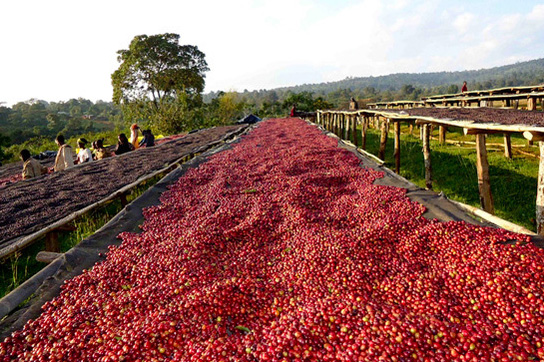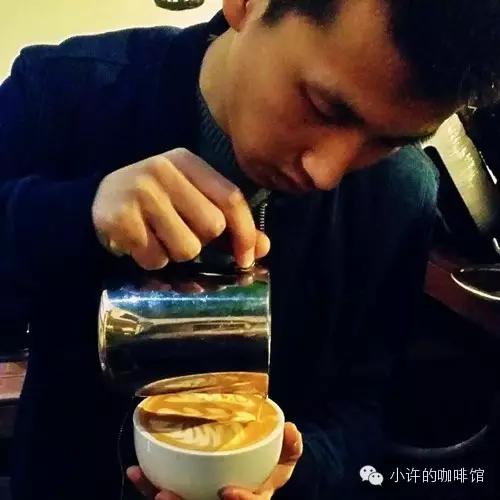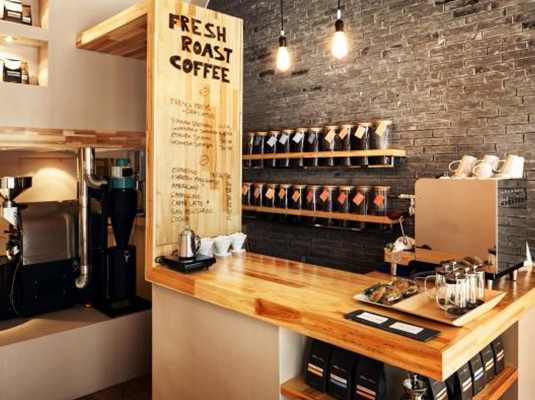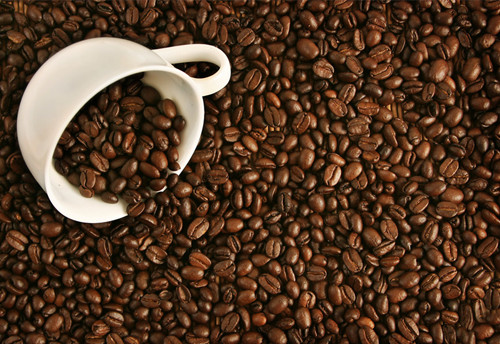Cherish every coffee bean is hard to come by.
I still remember when I was studying, the teacher said to me: to cherish every coffee bean, that is coffee farmers picked from the coffee tree, a little bit of exquisite processing, to cherish the coffee beans as well as cherish the grain.

At that time, I didn't understand why I was so cautious about coffee beans. I didn't know until a little bit later that it took so much processing for a small bean to become coffee in my cup, so hard-won. Learn how to go from a coffee tree to a coffee liquid when you meet you halfway across the world.

Coffee tree
Coffee belongs to the evergreen shrub of Rubiaceae, which grows in tropical and subtropical areas. Wild coffee trees can grow to more than 20 meters high and are artificially cultivated to be cut to a height of less than 2 meters for easy management. There are many different varieties of coffee trees, but the most common cash crops are Arabica and Robesta. Arabica varieties are excellent, accounting for 65% of the world's total output. Roberta is a low-quality variety, but it has high production capacity and strong resistance to diseases and insect pests, so it is mostly used to process instant coffee. It usually takes three years to blossom and bear fruit after the seedlings grow into a coffee tree, and a small flower as white as jasmine lasts only two or three days. Coffee flowers will bear a turquoise fruit, the fruit slowly grow, from green to yellow, mature to red, shaped like cherries, so coffee fruit in English is called cherry, red fruit has a thin layer of flesh, peeled pulp contains two opposite semi-oval seeds, that is, coffee beans (green bean).
So, how do you get the raw coffee beans inside the coffee fruit on the coffee tree?
Pick coffee fruit
The coffee fruit turns red when it is ripe, and the ripe coffee fruit should be picked as soon as possible, otherwise it will ripen too much and rot. Picking coffee fruits is generally divided into manual picking and machine picking. Manual picking is mostly used for high-quality Arabica coffee, or countries and regions with abundant labor force, while machine picking is mostly used for Roberta or low-quality Arabica coffee, which is suitable for working on large farms with flat terrain.
Coffee fruit processing
After the coffee fruit is picked, the pulp must be removed in order to get the raw coffee beans. There are also different ways to process this process. Generally divided into dry processing, wet processing and semi-dry processing.
Wet processing is to wash the picked coffee fruit, then soak and ferment the pulp to rot, then take off the pulp and wash the internal coffee seeds to dry to get coffee beans. The raw beans processed in this way generally have a clean and tidy appearance and a refreshing taste, but the processing requires technology and a lot of water.
Dry processing is to dry the picked coffee fruit directly on the drying ground, wait for the pulp to dry, and then use the machine to remove the pulp to get coffee raw beans. In this way, the processed raw beans are generally not neat enough to mix with sundries, and the purity of taste is not enough, but if processed, they will have richer taste and higher mellowness.
Semi-dry processing is to remove the flesh of freshly picked coffee fruit directly, then soak it with water, remove the pulp remaining on the coffee beans, and then wash and dry to get raw coffee beans. This method combines the advantages of the two methods, which is not only rich in taste, but also neat and uniform in appearance than the dry treatment.

Unhulled coffee beans
In particular, it should be pointed out that the raw coffee beans obtained by three processing methods all exist in the form of shell beans, which is the endocarp of coffee fruit, which is usually more conducive to the preservation of coffee beans. But the coffee beans before export have to be shelled in order to get raw coffee beans.
Grading of raw coffee beans
Although it is the same raw coffee beans obtained through production and processing, but different varieties, growth environment, cultivation methods and processing methods, the quality of coffee raw beans is also different, here is related to the classification of coffee raw beans. The grading of coffee beans varies from country to country and region, and there are several common ones:
1. Graded according to the particle size of raw coffee beans. In general, the larger the bean body, the higher the grade.
2. Graded according to the altitude of coffee planting. In general, the higher the height of the origin, the higher the grade.
3. Grading according to the number of defective beans. Coffee in the processing will inevitably be mixed with some moldy, rotten, incomplete beans or stone chips and other sundries, which will also affect the grading of coffee beans. The fewer defective beans, the higher the grade.
4. Graded according to the results of cup evaluation. After the raw bean samples were processed into coffee liquid according to the professional cup evaluation method, they were graded according to the analysis results of coffee taste.
Coffee roasting
Green coffee beans have no aroma and taste, so how can we get the cup of coffee we want? Here is a very critical step-coffee roasting.
Roasting is the process of roasting and heating raw coffee beans to change their internal matter and structure, from turquoise hard raw beans to brown larger coffee beans, and give play to their aroma and taste.
Coffee raw bean grinding
Roasted coffee beans are rich in aromatic ingredients, but if they come into contact with the air for a long time, they will be oxidized to volatilize the aroma and change the taste, so the roasted coffee beans should be sealed and packed and preferably used within two weeks. in order to maintain its best flavor.
When making coffee, the beans should be ground into coffee powder so that the aromatic components can be better extracted. And because the grinding powder has a larger contact area with the air and the oxidation rate is faster, it is necessary to grind the coffee before making it to maintain a better flavor.
Coffee extraction
The ground coffee powder is extracted with water and finally gets a cup of coffee. Here, according to the apparatus and water temperature, there are also a variety of extraction methods. Common ones are:
Make coffee. In the most primitive way, coffee was made in a long-necked pot in Ethiopia and in a golden saucepan in Turkey.
Make coffee. Siphon pots and Belgian pots use alcohol pots to heat hot water to extract coffee. They are called "burning" because they are heated by an alcohol lamp, which is a bit like doing a chemical experiment. It uses the principle of siphon in physics to push the hot water through the coffee powder. After removing the heat source, the coffee liquid falls into the coffee pot to get the extracted coffee.
Press the coffee. Espresso machine is the most typical way to extract coffee using the principle of compressed air. The coffee powder is driven by water vapor at 9 atmospheric pressure to quickly pass through the coffee powder to extract the aroma components of the coffee. Espresso itself means "pressure" in Italian. Coffee such as cappuccino and mocha, which are common in cafes, are mixed with milk cream on the basis of espresso. The mocha pot has the same principle, except that the pressure is only 2pm and 3 atmospheres, so you can't get the beautiful coffee grease on the surface of espresso, which is generally used for home use.
Filter the coffee. There are electric trickling filter pot, hand flushing pot filter with hot water extraction and ice water extraction with curling kettle (because the Dutch invented this device is also called Dutch coffee machine).

The above is the whole process of coffee from a coffee tree to a coffee liquid, and every step in this long process will affect the taste of the final cup of coffee, so coffee is not so simple to come to your cup, complex and long, this bean, perhaps halfway across the world, meets you from countless beans and turns into your own cup of coffee. Is it fate?
Source: Xiao Xu's Cafe
Important Notice :
前街咖啡 FrontStreet Coffee has moved to new addredd:
FrontStreet Coffee Address: 315,Donghua East Road,GuangZhou
Tel:020 38364473
- Prev

What kind of marketing strategy increases the performance of a cafe by 600%?
A coffee shop has not been very well run, the turnover is mediocre, but after that, the sales volume of the coffee shop has been increased by 600%. How can this be done? What kind of marketing strategy has made it change so much? First, tell the related merchants that if they spend more than 100 yuan here, they will give you a 100 yuan shopping card and a cup of coffee. Of course, this shopping card is a shopping card from the cafe.
- Next

Is there really no caffeine in the truth about decaf?
Many Americans are experimenting with decaffeinated coffee in the hope of getting a perfect cup of coffee that only tastes like coffee but does not stimulate the nervous system. But is decaffeinated coffee really decaffeinated? What's the difference between non-caffeinated and natural decaffeinated? Is it absolutely safe to remove caffeine from coffee? Before you know what your decaffeinated coffee is, you need to understand
Related
- Customers have "changed" Manner's new products! Shop assistant: Please don't mess around!
- Remove sockets in customer areas at Starbucks stores?! Netizen: I won't go if I really tear it down
- What is the difference between the taste steps of sun-dried coffee and washed coffee? Why is sun-cured coffee sweeter and washed coffee sour?
- The recipe for salty grapefruit dirty is revealed! Coffee Festival salty grapefruit dirty coffee making materials parameters ratio milk share!
- How about the flavor of Sunlight 74158 at Sidamo Banshaha Mathieu Processing Factory in Ethiopia? 74158 Share the proportion of coffee brewing parameters!
- What effect does Italian American coffee with filter paper have? Will coffee taste better if it is put on filter paper at the bottom of the powder bowl?
- What is the color difference in coffee beans? What are the characteristics of honey processed coffee beans? Why are the anaerobically treated coffee beans uneven in color?
- How does novice Xiaobai quickly get started and make coffee? Newbies learn to make coffee by hand and share the specific steps and process process!
- Costa tea has a shelf life of 100 years?! Expert: Unable to verify
- It's a huge uproar! American milk addition was rejected by Manner employees?!

